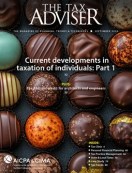- newsletter
- TAX INSIDER

Practical ways to enhance operational transfer-pricing processes
Please note: This item is from our archives and was published in 2022. It is provided for historical reference. The content may be out of date and links may no longer function.
Related
Notice 2025-27 provides interim guidance on corporate AMT
Two Tax Court rulings expose overvalued conservation easements
Late election relief in recent IRS letter rulings
This article identifies operational transfer-pricing concepts and the importance of establishing effective and efficient practices to gather, segment, and analyze data throughout the supply chain to achieve organizational goals associated with transfer pricing.
What is operational transfer pricing? The term refers broadly to the processes, often technology-enabled, that companies develop and use to implement, manage, adjust, and report their intercompany activities and execute the underlying transfer-pricing policies. Effective operational transfer-pricing execution encompasses the following:
- Understanding and implementing internal accounting, finance, and legal activities related to intercompany pricing;
- Developing specific internal controls for the implementation and memorialization of transfer-pricing policy workflows;
- Knowing supply chain activities and third-party contracting arrangements; and
- Predicting how business-related disruptions could impact the execution of intercompany pricing policies.
After first emphasizing the importance of understanding the organization, the authors highlight the global tax debate and then suggest ways to be proactive in preparing for business and regulatory disruptions that can occur.
Understanding the organization
Operational transfer-pricing concepts are relevant to companies in all industry segments, although they become more significant when the number of intercompany transaction types and the volume of transactions increase. In a global supply chain with different time zones, currencies, languages, cultures, business behaviors, accounting standards, and tax laws, multinational companies (MNCs) might not anticipate the disruptions or complications to intercompany activity that arise. Further, MNCs often fail to predict the costs of those complications or effectively manage workflows in this dynamic environment. Relevant operational transfer-pricing planning must consider the following questions:
- How prepared for disruption (e.g., merger/acquisition, loss of key personnel, or addition/subtraction of a key supplier) is a company that operates a global supply chain?
- Has the company considered where institutional knowledge exists within the organization, the processes and workflows undertaken, the systems used, and the internal, cross-department relationships that are relied upon?
- What are the consequences if effective tax rate goals are not met, cash flow cannot be efficiently deployed, or financial reporting is inaccurate?
Strong operational transfer-pricing practices lead to improvements in budgeting accuracy, reporting timeliness, internal continuity, and change agility. These benefits are important factors in optimizing cash flow deployment, effective tax rate efficiency, and supply chain communications, as well as mitigating tax risk (e.g., penalties or double taxation).
Global tax debate
Further complicating operational transfer-pricing matters is the global landscape of tax regulations and guidance.
Consider that MNCs are continuously adapting to the Organisation for Economic Co-operation and Development’s (OECD’s) compliance requirements and initiatives to bring greater transparency to MNCs’ intercompany activities. As governments demonstrate greater scrutiny of transfer pricing, which is often viewed as a high-risk area for tax base erosion, it is essential that MNCs adopt internal strategies, controls, policies, and practices to execute intercompany pricing that are aligned to their tax planning goals and global compliance requirements.
For example, corporate tax changes in the United States from the law known as the Tax Cuts and Jobs Act, P.L. 115-97, have changed how U.S.-parented MNCs approach international planning — and have placed them in potential future conflict with the effort of the OECD/G20 inclusive framework on base erosion and profit shifting (BEPS) to reallocate corporate profits to market jurisdictions and create global minimum taxation rules. Proposed legislation may eventually align U.S. rules more closely to evolving global guidance in the so-called BEPS 2.0, but the current environment has created significant complexities that MNCs must consider in adapting and optimizing for the road ahead. More immediately, MNCs will consider tax planning strategies in relation to the Inflation Reduction Act, P.L. 117-169, in the United States. As the tax strategies employed by MNCs change, it often follows that supply chain organization and economic risk profiles also change. As a result, the operational execution of transfer-pricing policies must adapt and be managed closely to not only achieve the MNC’s goals but also to mitigate risk upon examination.
The environment of heightened transparency in international tax and transfer pricing, combined with MNCs’ global breadth, is making transfer pricing an increasing focus for internal tax departments when it comes to acquisition planning and integration, foreign investment, cash management, and tax optimization. MNCs that adapt efficiently and proactively are likely to create significant benefits from accuracy and agility in decision-making that help management maintain operational and tax efficiencies, report in a timely fashion, and mitigate audit and double-taxation risk more readily.
Disruption and control
Disruptions have a significant impact on transfer-pricing processes and in-house tax departments. Common causes of disruptions impacting internal finance and tax departments include acquisitions and divestitures, industry-specific regulatory changes, tax law changes, loss of key internal resources and continuity, and marketplace disruptions such as the global pandemic. These disruptions increase team demands and lead to inefficiently allocated resources.
In a 2022 Crowe poll conducted during an operational transfer-pricing webinar, many corporate tax and finance leaders indicated that the management of tax and transfer-pricing processes needs to better align with supply chain and business operations. Only 10% of those polled believe they have sufficient, dedicated resources for managing transfer-pricing policies and results. Further, only 24% indicated that they are engaged with transfer-pricing matters throughout the year. Given the consequences and costs of failures in the execution of transfer-pricing policies, it stands to reason that operational transfer-pricing concepts and planning should become a higher priority for management.
Companies can evaluate certain behaviors to determine whether their organization is a good candidate for leveraging technology and implementing control concepts to improve their operational transfer-pricing processes. Consider the following questions in evaluating operational transfer-pricing readiness:
- Are year-end transfer-pricing adjustments causing negative income tax consequences or secondary impacts to customs and duties or indirect tax liabilities?
- Are transfer-pricing processes becoming too complex across multiple entities and enterprise resource planning systems to manage risk and reporting timelines, or to optimize effective tax rate, cash flow, and supply chain decisions?
- Does the tax and finance team have key process and institutional knowledge centralized among too few personnel, with the risk of undue continuity loss from personnel changes?
- Does management regularly struggle to respond to time-sensitive due diligence and acquisition integrations?
Practical first steps for improving operational transfer pricing include the following:
- Identify intercompany transactions that involve significant manual processes and the most frequent adjustments to adhere to policies;
- Identify personnel who manage manual processes that would be difficult to replicate without appropriate documentation of processes;
- Identify pain points and prioritize the areas that would yield the most benefit through an enhanced operational transfer-pricing plan;
- Evaluate how adept internal teams are with technology and the feasibility of providing in-house teams with new tools and technologies;
- Evaluate where more advanced technology assistance provides a meaningful cost/benefit analysis for the internal team; and
- Identify simplification measures that could be implemented for transfer-pricing policies while maintaining a similar economic outcome among the group’s related entities.
As global tax policies evolve, transfer pricing will continue to be a part of policy discussions; therefore, implementing and executing transfer-pricing policies needs to be a priority for management. Operational transfer-pricing considerations must go beyond basic implementation to include the management of institutional knowledge of the supply chain and tax/finance department policies, especially as they pertain to data, systems, processes, and personnel. Companies must be prepared to react to both internal and external disruptions to the organization to reduce the indirect costs of those disruptions.
— Danny McVeigh is a senior manager at Crowe LLP in New York City; Sowmya Varadharajan, Ph.D., is a principal at Crowe in Los Angeles; and John Lamszus, CPA, is a senior manager at Crowe in Chicago. To comment on this article or to suggest an idea for another article, contact Dave Strausfeld at David.Strausfeld@aicpa-cima.com.














